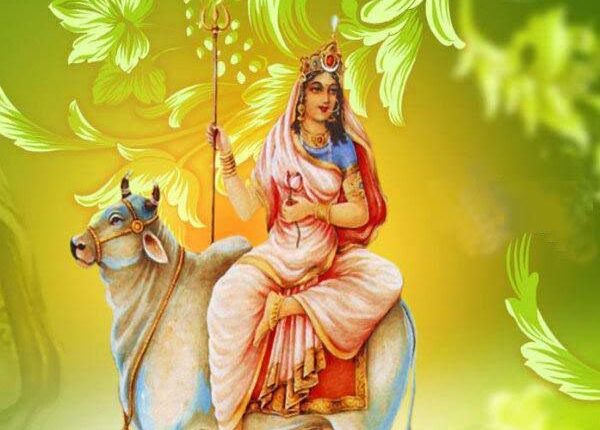The Nine Facets of Devi Durga : Know about Goddess Shailaputri
Exploring the Origins and Spiritual Significance of Goddess Shailaputri in Navratri
Navratri, a nine-day festival dedicated to the nine manifestations of Goddess Durga, begins with the worship of Shailaputri, the first form of the goddess. Each of these nine days is devoted to a unique form of Durga, and Shailaputri, literally meaning “Daughter of the Mountain,” is honored on the first day. Her name reflects her origin and her significant connection to the Himalayas. She is a symbol of strength, purity, and devotion, and her story holds deep mythological and spiritual significance.
The Mythological Origins of Shailaputri
The origin of Shailaputri is rooted in ancient Hindu mythology. She is believed to be the reincarnation of Sati, the first wife of Lord Shiva and the daughter of King Daksha. Sati was deeply devoted to Shiva, but her father, Daksha, disapproved of their union. This disapproval led to a dramatic turn of events that would result in Sati’s self-immolation.
According to the myth, King Daksha once organized a grand yagna (a ritualistic sacrifice) but deliberately did not invite Shiva and Sati. Despite Shiva’s warnings, Sati decided to attend the ceremony. At the yagna, Daksha insulted Shiva, which deeply hurt Sati. Sati immolated herself alive in the sacrifice fire because she could not take any more of the disdain for her spouse.
Heartbroken, Lord Shiva carried her charred body and performed the Tandava, a destructive dance, plunging the world into chaos. To restore balance, Lord Vishnu used his Sudarshan Chakra to dismember Sati’s body, which fell into 51 pieces, each becoming a Shakti Peeth—a holy site spread across India.
After this tragic event, Sati was reborn as Shailaputri, the daughter of the Himalayan King Himavat, and resumed her journey of devotion to Lord Shiva. This reincarnation symbolizes a fresh start, a new beginning, and the continuation of her union with Shiva.
Iconography and Symbolism of Shailaputri
In her depiction, Shailaputri rides a bull, named Nandi, which is a symbol of patience, strength, and the earth. She holds a trident (Trishul) in her right hand and a lotus flower in her left hand. The trident signifies power and authority, while the lotus is a symbol of purity and divine grace.
Her two arms represent balance, while the bull represents dharma, the moral law governing the universe. Shailaputri’s calm, composed demeanor reflects her purity and grace. She is often adorned in white attire, further emphasizing her association with purity, peace, and the serene heights of the Himalayas. As the daughter of the mountain, she embodies the strength, resilience, and steadiness that mountains symbolize.
Spiritual Significance of Shailaputri in Navratri
The first day of Navratri is dedicated to Shailaputri, and it marks the beginning of the devotee’s spiritual journey. Navratri, after all, is not just a festival, but a period of spiritual awakening, self-purification, and a time to honor the feminine divine. Worshiping Shailaputri is seen as a way to invoke the basic energy that governs all existence—Prakriti, the primordial energy that is responsible for the creation of the universe.
Support Independent Journalism? Keep us live.
On this day, devotees focus on grounding themselves and developing qualities like patience, determination, and discipline. Just like Shailaputri, who symbolizes strength and steadfastness, worshipers are encouraged to begin their spiritual journey with the same inner resolve and calmness. The goddess embodies the foundation of spiritual awakening, inspiring the first step toward enlightenment and liberation.
Shailaputri is also associated with the Muladhara Chakra, the root chakra in the human body, which governs the foundation of energy. By meditating on Shailaputri, devotees seek to awaken the dormant energies of the body and set the stage for spiritual growth throughout the rest of Navratri.
Rituals and Worship of Shailaputri
The rituals performed on the first day of Navratri are dedicated to invoking the blessings of Shailaputri. Devotees begin the day by cleaning their homes and offering prayers to the goddess. They set up a Kalash (sacred pot), which symbolizes the universe, and invite the divine energy of Durga into their homes.
The puja involves offering flowers, especially red hibiscus, fruits, sweets, and chanting specific mantras dedicated to Shailaputri. The following mantra is chanted to seek her blessings:
“Vande Vanchhit Laabhaay, Chandrardhkritshekharam
Vrisharudham Shooldharam Shailputrim Yashasvinim”
Translation: I worship the goddess Shailaputri, who fulfills the desires of her devotees. She who adorns a crescent moon on her forehead, rides a bull, and carries a trident, may she bless me with success.
Devotees also offer prayers to awaken the Muladhara Chakra and ensure the steady flow of energy in their spiritual pursuits.
Fasting is another key aspect of the worship. On this day, many devotees begin a nine-day fast in her honor, consuming only satvik (pure) food like fruits, milk, and water. This fast is not merely for physical purification but also symbolizes the beginning of a spiritual cleanse, allowing devotees to connect more deeply with the divine energy.
The Symbol of Resilience and New Beginnings
Shailaputri, the embodiment of strength and purity, is a reminder of the power of devotion, perseverance, and renewal. Her story of being reborn after Sati’s tragic death serves as an inspiration for resilience in the face of adversity. As the first manifestation of Goddess Durga, she lays the foundation for the spiritual journey that unfolds during Navratri.
By invoking Shailaputri, devotees seek her blessings for a strong beginning, ensuring that their spiritual and worldly endeavors are guided by patience, purity, and steadfastness. As they proceed through the nine days of Navratri, her qualities of strength, determination, and calmness remain with them, making her a central figure in the journey toward spiritual awakening and divine grace.


Comments are closed.